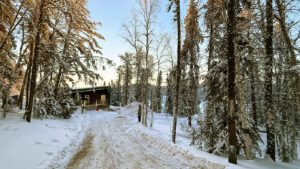The ten-week On-The-Land Program for Yellowknife homeless is a welcome relief from the stresses and triggers of living on the streets, say participants.
The alternative to overcrowded and dangerous downtown shelters is so appreciated, that those CKLB spoke with during a recent visit said they hoped the territorial government would find a way to develop a permanent camp, especially as the abstinence policy is helping to break the cycle of addictions to street drugs and alcohol.
Tiffany Thrasher’s addictions and past traumas forced her from a living arrangement onto the streets, where she ended up at the large homeless encampment beside the boarded-up Aspen Apartments in Yellowknife.

Tiffany Thrasher experiences a range of emotions when meeting media earlier this week at the On-The-Land Camp at the Camp Connections setting on the Ingraham Trail outside of the city. The photo showing her hands is when she was laughing. (James O’Connor/CKLB)
“A lot of bad things had happened in that camp … drugs … I got hurt in many ways, and I am glad I’m still alive,” she said, sitting in the lively main dining hall and gathering space earlier this week.
Thrasher called the 10-week camp – where she arrived a week and half ago – a “blessing” and she hopes to continue her sobriety in a program when she returns to Yellowknife.
“Being on the land is really healing. It makes me feel closer to Jesus, it makes me feel closer to the Creator. And out here I can scream as loud as I want. Nobody’s going to tell me to stop,” she said.
“I find life to be clearer, happier, more vivid. I find it way better to begin sober, way better.”
And her message to Premier R.J. Simpson: “I would say, throw as much funding as you could into programs like this. Keep it rugged, keep it real, smarten up because you don’t know what it’s like to you on the streets. You don’t know what it’s like to be an addict. You don’t know what it’s like to have your home taken from you.

A freshly plowed road up to the main gathering building at the On-The-Land Camp at Camp Connections on the Ingraham Trail outside of the city. (James O’Connor/CKLB)
“So, throw funding to programs like this. Believe in healing. Believe that people can change.”
The GNWT set up this temporary campsite at the Foster Family Coalition’s Camp Connections on the Ingraham Trail, accommodating 20 to 30 homeless people who can pledge to stay clean and sober this winter.
Those numbers haven’t been reached, as admission requirements are firm.
But the non-profit running the camp for the GNWT – called NWT Integration and Community Services (NWT-ICS) – is pleased with the results so far.
On the day CKLB visited, there were 10 residents. Sixteen has been the high count. People decide to leave for any number of reasons, but all have done so voluntarily to date, says Eric Neba, the executive director of NWT-ICS.
When the camp was announced last month, the GNWT stated it was designed to alleviate pressure on the city’s shelter system by offering an “alternative, abstinence-based environment focused on stability and wellness.”

Messages, artwork and a menu can be found on the On-The-Land Camp. (James O’Connor/CKLB)
But at at a cost of $642,000, it’s not cheap. Some simple math shows it costs government $917 per each of 10 participants. If the full capacity was reached, the daily cost per person drops to with 10 participants, it costs roughly $320 each.
The GNWT regularly spends $200 to $500 or more daily to send Northerners to one of five treatment centres currently on the approved list.
A debate over the value of a residential treatment centre in the NWT – or as one Regular MLA argued for in the last session, one small centre in each region – remains ongoing, with the GNWT standing firm on its policy if using southern centres.
Another resident William McAllister who was sleeping at shelters in Yellowknife, until he made the decision to dry out for three days and head out to the camp.
“Everything is peaceful, quite beautiful … I feel safe being away from town — it’s easy to get triggered in town,” said the construction worker.
“Everything is so accessible, and you’re around people that are always using and drinking. You know, it’s so easy to get.”
With artwork and hand-printed lesson notes posted on the walls of the gathering area, it’s clear that 12-step recovery options are being explored by the counsellors.
As some clients could encounter medical emergencies, there is a round-the-clock paramedic on site.
Camp staff are also trained in de-escalation measures, though nobody has been ejected from the program.

NWT-ICS executive director Eric Neba. (James O’Connor/CKLB)
Another rule is that clients are not allowed to go out of sight of staff, without first notifying them of their intentions.
What else do the residents do each day?
They wake up at about 6 a.m., with breakfast is served an hour later.
After breakfast, staff find out how the night was for residents, to determine if there were any concerns.
Then during the day counsellors come in twice a week and traditional Elders who come in three times a week. One Elder comes in for outdoor activities, including smudging.
Another round of check-ins follows each evening with residents, followed by an evening of activities, such as crafts.
NWT-ICS executive director Eric Neba said, “some clients actually are really good on the land for rabbit trapping … so sometimes in the evening, that’s when they go out to check on catches.”
Louis Mutaradlaluk has taken on chopping wood. And he has chopped a lot of it.

Louis Nutaradlaluk outside a dorm cabin at the 10-week On-The-Land Camp at the Camp Connections setting on the Ingraham Trail outside of the city. (James O’Connor/CKLB)
“It’s really awesome here … no distractions, no temptations, especially for indigenous people, he said standing outside his bunkhouse cabin.
“This is what should have been thought of long time ago.”
So, what is going to happen at the end of January to the On-The-Land Camp and its residents?
After all, it is completely different than what is offered in the city by the existing network of emergency shelters, a collection of various 12-step meetings at downtown locations, alleys full of dealers and streets full of day drinkers.
The GNWT maintains the primary intent of the On-The-Land Camp is to provide additional temporary safe shelter spaces and reduce pressures on existing emergency shelters in Yellowknife over the winter.
A spokesperson told CKLB that any discussion on extending the camp would be dependent on various factors including need, site availability, continued funding, and possible alternative shelter options.
CKLB was told in direct terms by one resident not to use the term “shelter” for the camp, as it is so much more than that.
So, what about all those requests to have the GNWT build its own camp, modelled after the current program out on Ingraham Trail?

A sign at the entrance of the On-The-Land Camp at Camp Connections on the Ingraham Trail outside of the city. (James O’Connor/CKLB)
The GNWT states it is focusing its efforts on increasing supportive and transitional housing options through actions outlined in A Way Home, the GNWTs homelessness strategy.
The GNWT is aware of conversations occurring among some Indigenous Governments and NGOs about establishing more on on-the-land options, but at this time is not directly involved in these conversations.
Back to the conversation CKLB had with resident Tiffany Trasher.
“I don’t want to live in a tent again. I don’t want to walk the streets in minus 60 or whatever the heck it’s going to be. I am afraid to go out there, because when I use (drugs) you tend to lose your mind, tend to lose hope, and when you’re homeless, it’s easy to give in,” she said.
“So, I am scared to leave until I get a place, or I go down south, which I said I don’t want to do. So, yeah, if this place was open longer, I would stay here for a while.”





